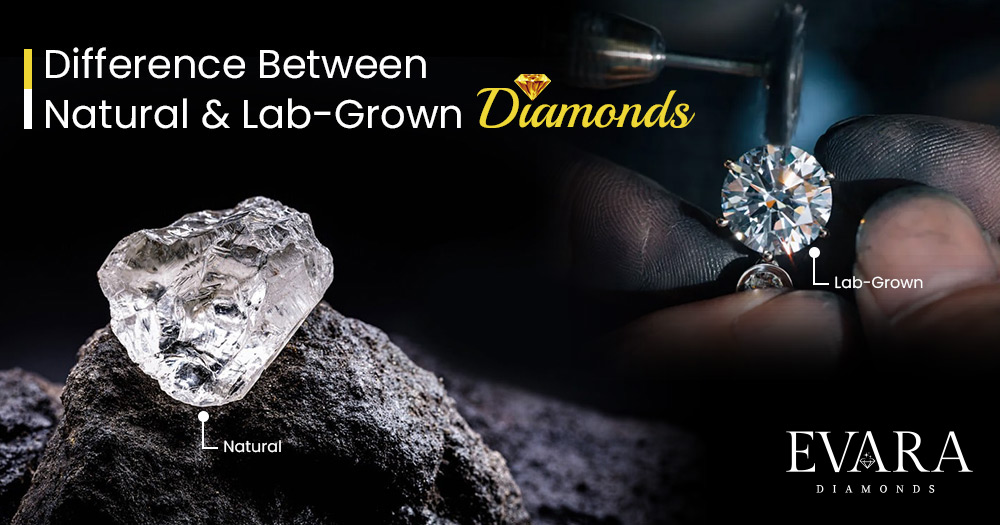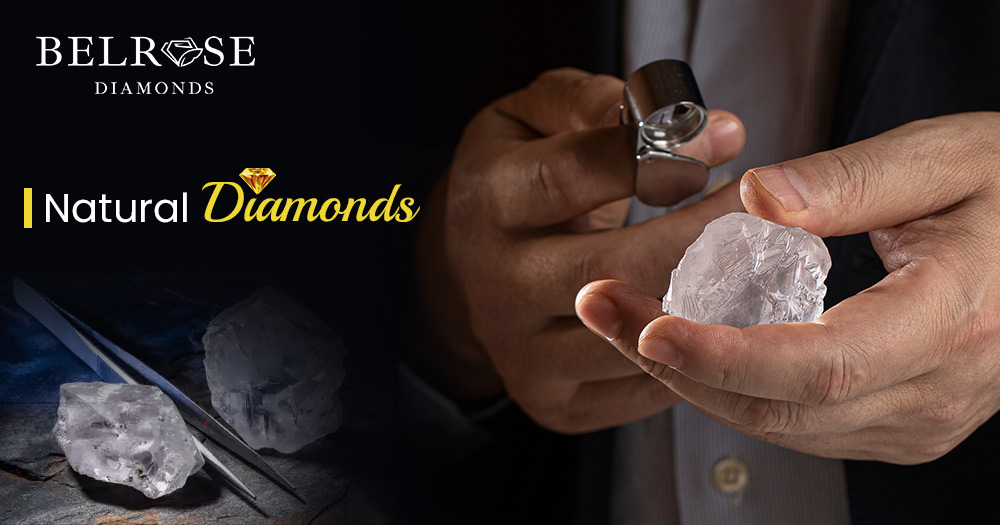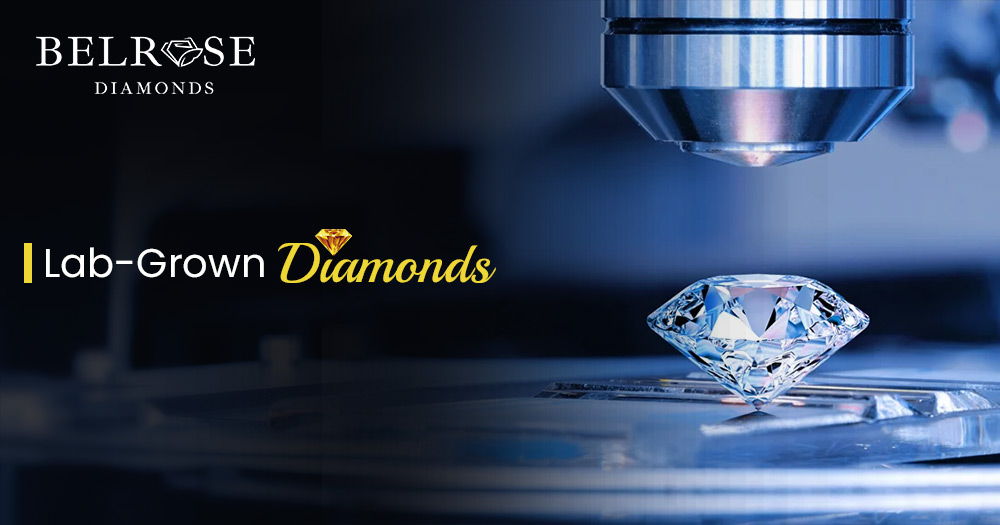Difference Between Natural and Lab-Grown Diamonds

Nature is filled with love and adorableness, and so are the natural diamonds. The loose natural diamonds have been ruling the world of luxury, making their place in the crowns of royal families for centuries. While lab grown diamonds have also been introduced in the market lately, the choice of people toward natural diamonds had hardly any impact. Whenever it comes to buy a natural stone with 100% purity and earth-imparted spark, natural diamonds are the one who takes the win.
As per the research from Tenoris, 82.7% of the total market share is owned by natural diamonds as of 2023. This statistical data well represents the preference of population toward natural diamonds because of its originality, purity and rarity.
If you are also tricked between these two options, this blog will help you know why natural diamonds have been the choice of world for centuries and what should be your choice by considering some key determining factors-
What are Natural Diamonds?

Natural diamonds are precious gemstones formed over billions of years deep within the Earth’s mantle under extreme conditions of high pressure and temperature. They are made up of pure carbon atoms arranged in a highly ordered crystalline structure, giving them their characteristic hardness, brilliance, and fire. Natural diamonds are considered to be one of the rarest and most valuable gemstones in the world.
Here are some of the key characteristics of natural diamonds:
1. Chemical composition: Natural diamonds are composed of pure carbon atoms arranged in a cubic crystal lattice structure.
2. Hardness: Natural diamonds are the hardest known natural substance on the Mohs scale of hardness, ranking 10 out of 10. They are so hard that they can only be scratched by other diamonds or synthetic diamond simulants.
3. Brilliance: Natural diamonds exhibit exceptional brilliance, meaning they reflect light with a sharp, sparkling appearance. This is due to the highly symmetrical arrangement of their carbon atoms.
4. Fire: Natural diamonds also display high fire, meaning they refract light into a rainbow of colors. This is due to the inclusion of impurities, such as nitrogen atoms, in their crystal structure.
5. Color: Natural diamonds can range in color from colorless to yellow, brown, blue, green, pink, or red. The color of a diamond is determined by the presence of certain impurities in its crystal structure.
6. Clarity: Natural diamonds are graded according to their clarity, which refers to the absence of inclusions or blemishes. The higher the clarity grade, the less visible the inclusions will be.
| Pros of Natural Diamonds | Cons of Natural Diamonds |
|---|---|
| 1. Rarity and Uniqueness– Natural diamonds are only produced by nature under rare circumstances and environmental contributions. So, they are any time more rare and unique as compared to lab-grown diamonds. | 1. Environmental Impact– Mining natural diamonds can have a significant negative impact on the environment, including habitat disruption and water pollution. |
| 2. Durability– Natural diamonds are extremely hard and durable, making them suitable for everyday wear and long-lasting. | 2. Ethical Concerns– Some natural diamonds may be associated with ethical issues, such as conflict diamonds or “blood diamonds” that have been used to finance armed conflicts. |
| 3. Resale Value– Natural diamonds often retain or appreciate over time, making them a potential investment. | 3. Cost- Natural diamonds are typically more expensive than their lab-grown counterparts, making them less accessible for some consumers. |
| 4. Sentimental Value– Natural diamonds may carry sentimental value, passed down through generations. | 4. Lack of Customization– Natural diamonds are limited in terms of size, shape, and color, which may not suit every individual’s preferences. |
What are Lab-Grown Diamonds?

A lab-grown diamond, also known as a synthetic diamond or cultured diamond, is a diamond that is created in a controlled laboratory setting rather than being mined from the earth. This means that they are not formed under the same geological conditions as natural diamonds, but rather through scientific processes that replicate these conditions in a controlled manner.
While both lab-grown and natural diamonds exhibit the same physical properties, lab-grown diamonds are often regarded as inferior due to their artificial origin and perceived lack of rarity. Natural diamond’s formation over billions of years in the Earth’s depths imbues them with a unique beauty and value that cannot be replicated in a laboratory.
Years of excellence in diamond manufacturing. Find best Diamond for you.
The Difference Between Lab-Grown and Natural Diamonds
The difference between lab-grown and natural diamonds is a topic of growing significance in the jewelry industry. While both share the same dazzling beauty, they are distinct in origin, cost, and ethical considerations. Understanding these disparities can help individuals make informed choices when selecting the perfect gem for their needs and values.
The formation journey
Natural diamonds are formed deep within the Earth’s mantle under extreme pressure and temperature over billions of years. The carbon atoms in the mantle are subjected to immense heat and pressure, which causes them to bond together in a diamond lattice structure. This process is incredibly slow, and it is estimated that it takes about 1-3 billion years for a natural diamond to form.
Natural diamonds are the hardest natural substance on Earth, with a Mohs hardness rating of 10. This means that they can only be scratched by other diamonds or synthetic diamond simulants. Natural diamonds are also very durable and can withstand high temperatures and pressures.
On the other hand, Lab-grown diamonds, also known as cultured diamonds or synthetic diamonds, are created in a controlled laboratory setting. There are two main methods for growing lab-grown diamonds: High Pressure High Temperature (HPHT) and Chemical Vapor Deposition (CVD).
So, it can easily be observed that natural diamonds takes a win when considering the formation journey of both the options. While lab-grown diamonds are man-made objects, natural diamond are a result of natural and rare phenomenon that takes centuries to give this precious stone.
Read Also: The Most Famous Diamonds in the World: Their Stories and Legends
Price
While lab-grown diamonds are more affordable, natural diamonds still hold a premium in the market. This is due to several factors, including their rarity, their natural origin, and the perception that they are a better investment. Natural diamonds have been prized for centuries for their beauty and durability. They are often seen as a symbol of love, commitment, and wealth. Lab-grown diamonds, on the other hand, are a relatively new phenomenon. They have only been available commercially for a few decades, and they are not as widely accepted as natural diamonds
| Feature | Natural diamonds | Lab-grown diamonds |
|---|---|---|
| Average price | $10,000 per carat | $7,000 per carat |
| Price range | $5,000 to $20,000 per carat | $4,000 to $14,000 per carat |
| Factors affecting price | Carat size, clarity, color, and cut | Carat size, clarity, color, and cut |
Durability
When it comes to durability, natural diamonds, and lab-grown diamonds stand as the hardest natural substances on Earth, both possessing a Mohs hardness rating of 10. Despite sharing this remarkable durability, natural diamonds hold a slight edge over their lab-grown counterparts in terms of thermal stability. Natural diamonds can withstand higher temperatures without undergoing structural changes or losing their brilliance. This attribute is attributed to their natural formation over billions of years under intense pressure and extreme heat, refining their crystalline structure to withstand thermal stress.
In contrast, lab-grown diamonds may exhibit slight color changes or even fracture when exposed to extreme temperatures. This susceptibility is due to their relatively shorter formation process, which may not fully replicate the natural conditions that enhance thermal stability.
Clarity
When it comes to clarity, natural diamonds often hold a slight edge over their lab-grown counterparts. The extreme environment in which natural diamonds are formed often results in the presence of microscopic inclusions or blemishes within the diamond’s crystal structure. These inclusions can range from tiny specks to more visible feathers or clouds, and their presence affects the diamond’s clarity grade.
Lab-grown diamonds, on the other hand, are created in a controlled laboratory setting that mimics the conditions of the Earth’s mantle. While the process of growing lab-grown diamonds has advanced significantly, it still cannot replicate the billions of years of geological processes that natural diamonds undergo.
Color
Both types of diamonds can range from colorless to near colorless, faint, very light, and light. The color grading system used for diamonds, known as the Gemological Institute of America (GIA) color scale, applies equally to both natural and lab-grown diamonds.
Natural diamonds, due to their formation over billions of years under extreme conditions, can sometimes exhibit subtle traces of impurities that impart unique color hues. These subtle color variations, often described as “fancy colors,” are highly valued in natural diamonds, contributing to their rarity and desirability.
In contrast, lab-grown diamonds, while technically flawless and chemically identical to natural diamonds, may lack these subtle color variations due to the controlled environment in which they are created. This difference in color nuance can be discerned by experienced gemologists using specialized equipment.
Conclusion
Natural Diamonds as well as lab-grown diamonds, both have their pros and cons along with the preference among the population. However, it can be concluded that natural diamonds are way more precious than artificial ones, as a few-month-old craft can not compete with the purity and shine of millions of years old stone. Artificial diamonds undoubtedly save a couple of dollars for the buyers, but still, they can not compete with natural diamonds.
FAQs
1. What kind of diamond should I choose?
If you are looking for a precious and real stone with all the components added by nature itself over a period of millions of years, you must go for natural diamonds. On the other hand, if you wish to save some dollars and the originality of the diamond doesn’t concern you that much, lab-grown diamonds can be the best fit for you.
2. Can the average person spot the difference?
The variances between Natural Diamonds and Lab-Grown Diamonds are imperceptible to the unaided eye. Natural Diamonds contain minuscule traces of nitrogen, whereas Lab-Grown Diamonds lack nitrogen entirely. This distinction serves as one of the criteria employed by gemologists to discern whether a diamond is created in a laboratory or occurs naturally.
3. Are lab-grown diamonds valued less than natural diamonds?
Yes, natural diamonds are more precious as well as valuable, when compared to lab-grown diamonds. There is a price difference of atleast 30%-50% between both types of diamonds.